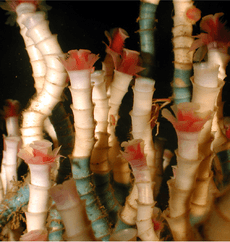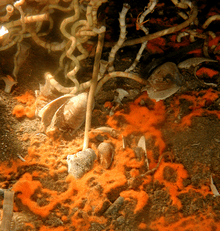Lamellibrachia facts for kids
Quick facts for kids Lamellibrachia |
|
|---|---|
 |
|
| Scientific classification | |
| Kingdom: | |
| Phylum: | |
| Class: | |
| Order: |
Sabellidae
|
| Family: |
Siboglinidae
|
| Genus: |
Lamellibrachia
|

Lamellibrachia are amazing cold seep tube worms that live deep in the ocean. They are related to the famous giant tube worms. These worms make their homes near special spots on the ocean floor called cold seeps. At these seeps, things like crude oil and methane slowly leak out from the Earth.
Contents
Discovering Lamellibrachia
Lamellibrachia worms can grow very long, sometimes up to 3 metres (about 10 feet)! They also live for a very long time. Scientists believe some individuals can live for over 250 years. This makes them one of the longest-living animals known.
How They Live: A Special Partnership
The Lamellibrachia worm has a very special partnership, called a symbiosis, with tiny bacteria. These bacteria can eat chemicals like sulphides. The worm helps the bacteria by giving them hydrogen sulphide and oxygen. It collects these chemicals from the water and carries them using a special protein called haemoglobin (like the one that carries oxygen in our blood!). In return, the bacteria make food for the worm. It's a perfect team!
Deep-Sea Homes: Building a Community
These worms don't live alone. They form huge groups of hundreds or even thousands of individuals. These groups create a special living space, or 'biogenic habitat', for many other creatures. Over a hundred different species of animals live in these worm communities. Many of these species are found only at these unique cold seep locations.
Cold Seeps vs. Hydrothermal Vents
Cold seeps are special places, just like hydrothermal vents. They are the only known places on Earth where life doesn't depend on sunlight for energy. Instead, they use chemicals! This process is called chemosynthesis.
However, cold seeps are different from hydrothermal vents. Hydrothermal vents are hot and often don't last very long. Cold seeps, on the other hand, leak oil and gas slowly. Because they are cooler and more stable, many animals living at cold seeps, like Lamellibrachia, live much longer than those at hydrothermal vents.

